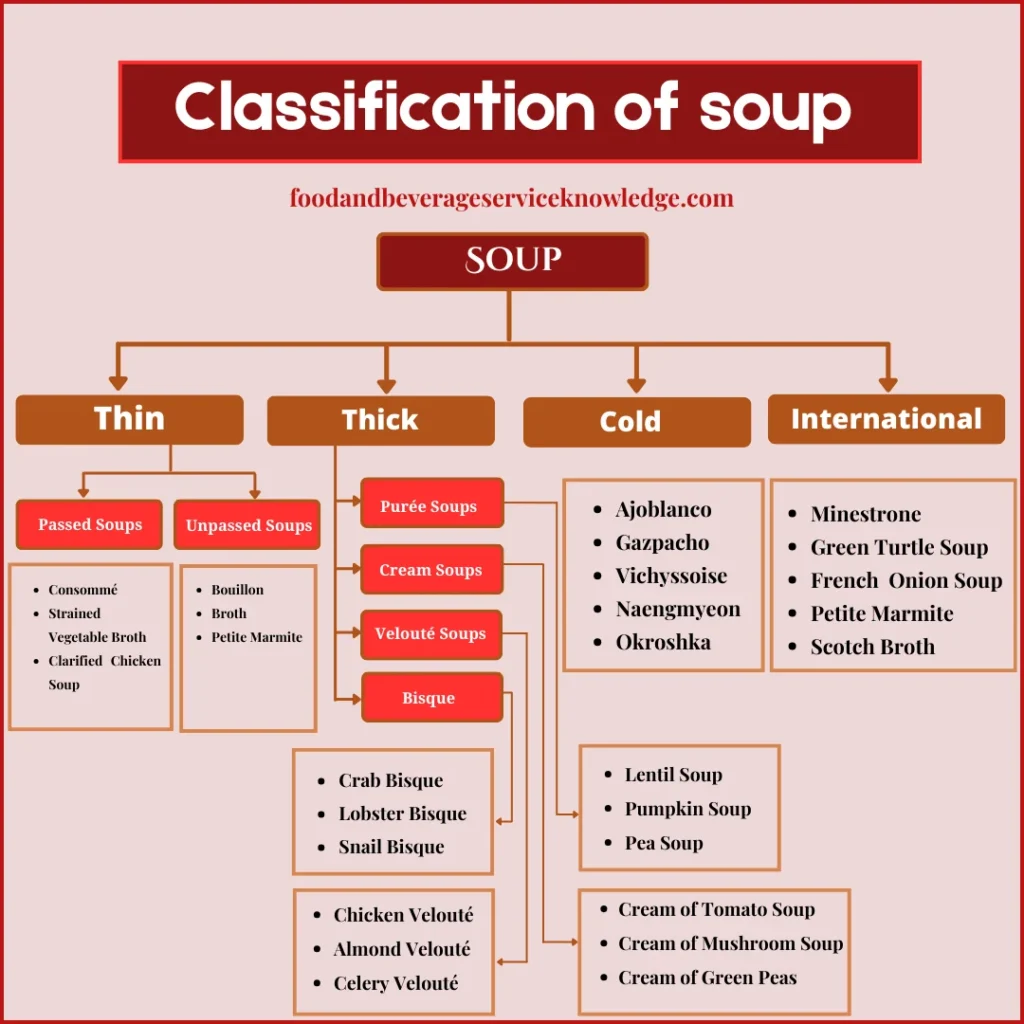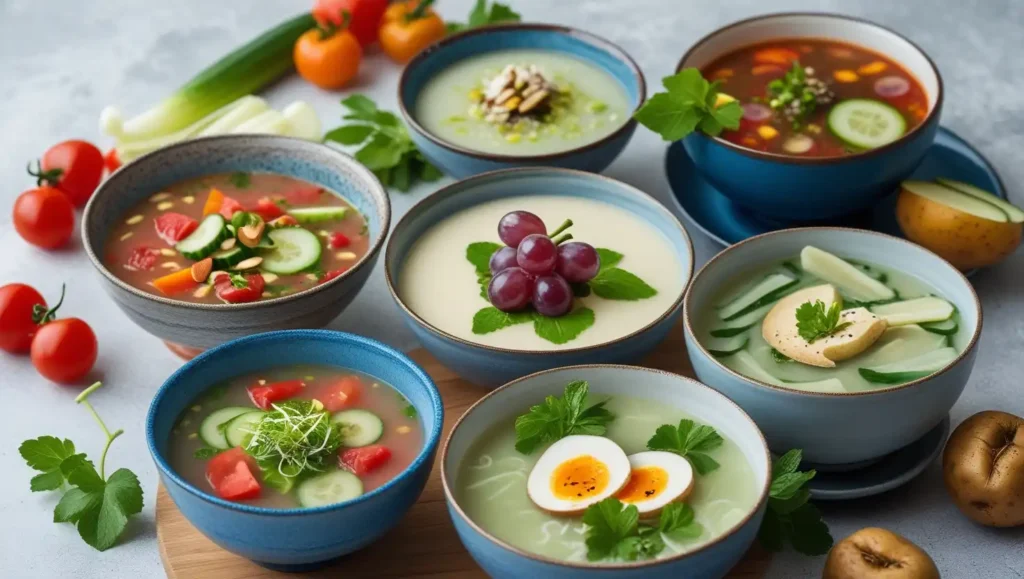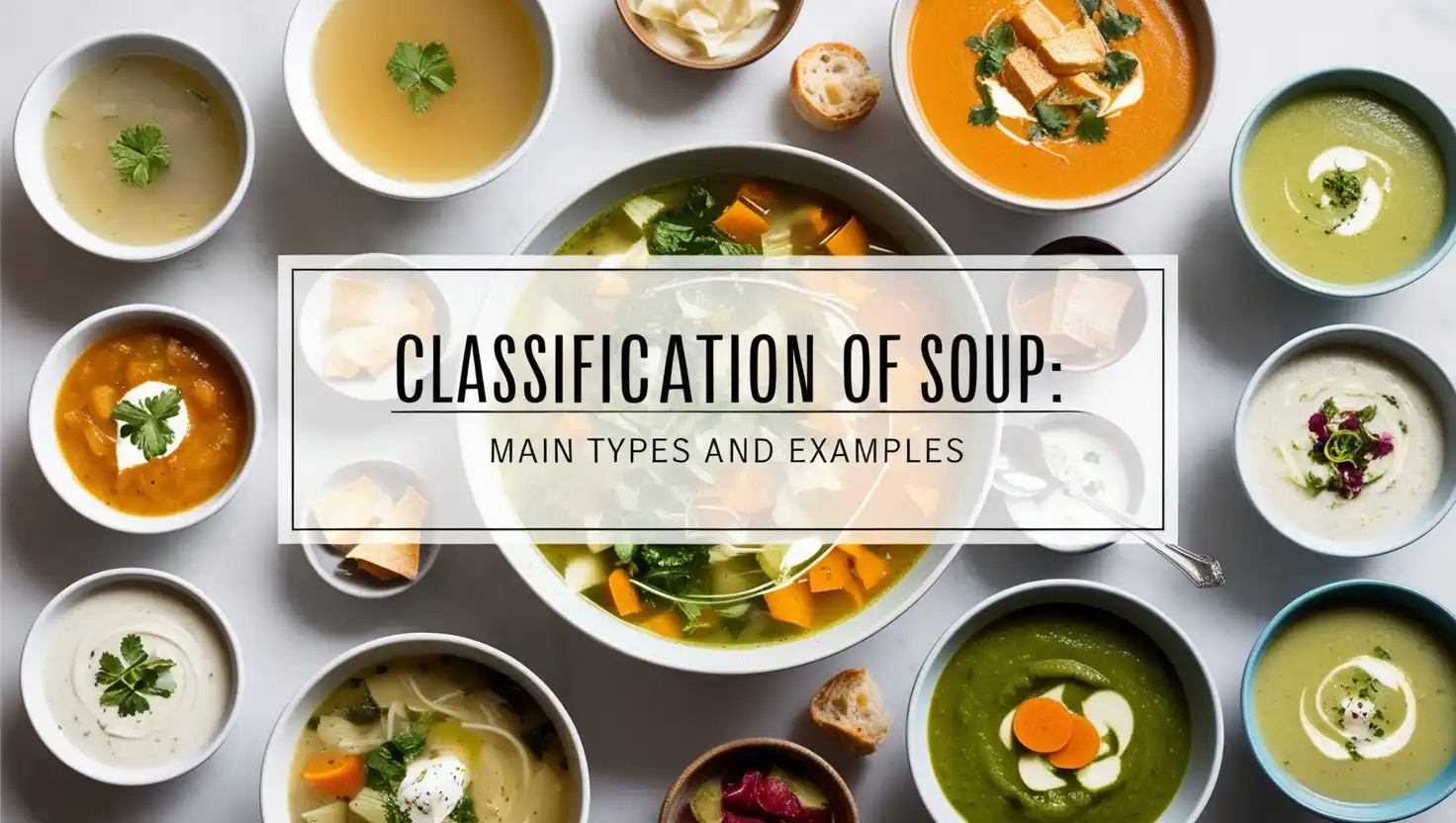Soup is one of the oldest and most universal dishes in human history, found in nearly every culture and cuisine. From simple broths to hearty chowders, elegant bisques, and refreshing cold soups, this humble liquid dish offers a rich blend of nutrition, tradition, and technique.
In culinary education, understanding the classification of soups is essential. It helps organise different styles, teaches the methods behind each type, and connects you to the cultural and historical roots behind every recipe. As the second course in the French classical menu, soups hold an important place in formal dining traditions. This guide explores the major categories of soup, explains their key features, shares global examples, and outlines preparation techniques, providing both theoretical knowledge and practical insights.
In this guide, discover the main types of soups, from thin and thick to cold varieties. Learn about their characteristics, examples, and preparation methods to deepen your understanding of global soup classifications.
Here’s a quick overview chart of soup classifications to help you understand the main types at a glance.

Main Categories of Soup
Most culinary traditions agree on two primary categories:
- Thin Soups
- Thick Soups
We will also explore:
- Cold Soups
- International Soups
Each category holds countless variations, history, and regional adaptations.
Thin Soups:
Thin Soups are light, clear broths or stocks made without any thickening agents. They focus on delivering clean, concentrated flavours from carefully simmered ingredients. Often served as appetisers, they are designed to gently awaken the palate.
Their clarity and simplicity highlight precise preparation and balance, and are classified into two types:

1. Passed Thin Soups (Strained)
These are clear broths that have been carefully strained to remove all solid pieces. They are smooth, light, and delicate in both taste and appearance. These soups focus on pure, refined flavours without any added texture. They are often served as elegant starters to gently begin a meal.
Examples:
- Consommé: A classic French clear soup, clarified using egg whites to remove impurities, resulting in a brilliant amber liquid with intense flavour.
- Strained Vegetable Broth: A clear broth made by simmering vegetables, then straining for a clean finish, often used as a vegetarian alternative to meat broths.
How It’s Made:
The key to a great passed soup is careful simmering, skimming, and straining. The process often involves a “raft” made of egg whites and mirepoix (vegetable base) to trap particles during clarification. This delicate step requires precision and patience.
Pro Tip:
Serve in warmed bowls to maintain the perfect temperature and preserve the delicate mouthfeel. Adding a touch of fortified wine, like Madeira or sherry, just before serving can elevate the flavour.
Learn the art of making a classic French chicken consommé, Honest Food Chicken Consommé Recipe
2. Unpassed Thin Soups (With Solids)
These are clear soups that contain small pieces of meat, vegetables, or grains. They are more filling and homestyle compared to fully strained soups. These soups combine a tasty broth with added texture from the solids. They offer both light flavour and satisfying bites in each serving.
Examples:
- Bouillon: A light broth, usually based on meat or poultry, with small floating garnishes such as brunoise vegetables or herbs.
- Broth: More robust than bouillon, often featuring vegetables, meat chunks, and sometimes grains like barley or rice.
- Scotch Broth: A Scottish classic made with lamb or mutton, barley, and root vegetables — thickened slightly by the starch from the barley but still considered a thin soup.
- Petite Marmite: A French broth served with small cuts of meat and carefully selected vegetables, often garnished with chopped parsley or chervil.
Serving Tip:
Use small garnishes like chopped herbs, finely diced vegetables, or delicate noodles for visual appeal and texture variation. A drizzle of high-quality olive oil or a sprinkle of finishing salt can transform the presentation.
Thick Soups:
Thick soups have a dense, rich consistency, created by adding thickening agents like roux (a butter-flour mixture) and cream or by puréeing main ingredients. They are hearty, filling, and deeply flavorful, often served as a main dish or a substantial appetiser. These soups provide not only warmth and comfort but also showcase a variety of textures and preparation techniques. They can range from smooth and creamy to chunky and rustic, depending on the type and ingredients used.

Below are the main types of thick soups, their preparation methods, and key characteristics:
1. Purée Soups
Purée Soups are thick soups made by blending starchy vegetables like potatoes, lentils, or pumpkin.
These vegetables naturally thicken the soup without needing extra agents like flour or cream.
The result is a smooth, creamy texture with rich, earthy flavours. They are simple, hearty, and often served with toppings like croutons or herbs for added taste and texture.
Examples:
- Pea Soup: Often made with split peas, onions, carrots, and ham or bacon, slow-cooked and puréed for a smooth, hearty texture.
- Lentil Soup: A Middle Eastern and Mediterranean staple, combining lentils with aromatic vegetables and spices.
- Potato Soup: Creamy and rustic, often flavoured with leeks, onions, or cheese.
Preparation:
Vegetables are cooked until soft, then blended into a smooth purée. Often, no extra thickener is needed because the starch content naturally thickens the liquid.
Cultural Note:
Many rustic European peasant soups fall under this category, prized for being filling, affordable, and adaptable to seasonal ingredients. These soups were often made in large batches and reheated over several days.
2. Cream Soups
These are made by blending puréed vegetables, meat, poultry, or fish with a béchamel sauce or cream.
They are known for their smooth, velvety texture and rich, comforting flavour. The addition of cream or milk gives these soups a luxurious, silky finish. They are often garnished with herbs, croutons, or a drizzle of cream for extra appeal.
Examples:
- Cream of Mushroom: Rich and earthy, often featuring blended or finely chopped mushrooms.
- Cream of Asparagus: Bright green and delicate, balancing the vegetable’s grassy notes with the richness of cream.
- Cream of Chicken: Comforting and smooth, sometimes finished with shredded chicken pieces.
Technique:
Prepare a roux (butter + flour), add stock, puréed main ingredient, and finish with cream for a luxurious texture. Seasoning carefully is key — the richness can dull flavours if under-seasoned.
3. Velouté Soups
Velouté Soups are prepared by blending a light roux with stock and puréed vegetables, meat, poultry, or fish.
They often include hot milk for a smooth, creamy consistency. A liaison (a mix of cream and egg yolks) is added at the end to enrich the flavour and texture. These soups are elegant, balanced, and offer a refined, silky finish.
Examples:
- Chicken Velouté: Made with chicken stock and flavoured with delicate herbs.
- Fish Velouté: Using fish stock, often paired with light herbs or wine.
- Celery Velouté: An elegant and aromatic vegetable-based version.
Chef’s Secret:
Whisk in the liaison off the heat to avoid curdling and ensure a glossy, smooth finish. Gentle reheating is crucial.
4. Bisques
Bisque is a rich, slightly thick soup made from shellfish purée, often thickened with rice or cream.
It typically contains small pieces of cooked shellfish, adding both texture and flavour. A splash of wine is usually incorporated to enhance depth and richness, giving the soup a complex taste. Bisques are known for their smooth, creamy consistency and luxurious, savoury profile.
Examples:
- Lobster Bisque
- Crab Bisque
- Shrimp Bisque
Interesting Fact:
Classic bisques were originally thickened with ground rice, not flour, lending a very fine, delicate texture.
Serving Idea:
Top with a drizzle of sherry or brandy, garnish with fresh herbs like tarragon or chervil, and serve alongside crusty bread or puff pastry.
5. Chowders
These are hearty, rich soups that originated in America, known for their thick and filling texture. They are typically thickened with potatoes and have a base of milk or tomatoes. Chowders often include ingredients like onions, bacon, seafood, and a variety of seasonings, adding depth and flavour. These soups are comforting, flavorful, and perfect for a satisfying meal.
Examples:
- New England Clam Chowder (creamy): White, rich, and brimming with clams, potatoes, and often bacon.
- Manhattan Clam Chowder (tomato-based): Lighter and more acidic, with a tomato base.
- Corn Chowder: Sweet, creamy, and hearty, often featuring potatoes and bacon or ham.
Fun History:
The word “chowder” is believed to come from the French word “chaudière,” referring to the pot in which fishermen cooked their catch.
For more inspiration on thick soups, explore this rich Thick Celeriac Soup with Gruyère recipe from Serious Eats. Thick Celeriac Soup with Gruyère Recipe – Serious Eats
Cold Soups
Cold soups are served chilled or at a cool temperature, making them ideal for warm weather, especially in summer. They are often thickened using natural agents like gelatin, starch, or purées, creating a refreshing alternative to hot soups.

Unlike hot soups, cold soups are not served ice-cold, as excessive chilling can dull their flavours and aromas.
Types: Cold soups can be:
- Thin or Thick
- Passed or Unpassed
However, they don’t form a distinct classification in traditional soup types.
Cold soups are often referred to as “summer delights” and are typically served in pre-chilled bowls or cups to maintain their refreshing nature.
Famous Cold Soups are:
- Gazpacho (Spain): Raw vegetables like tomatoes, cucumbers, and peppers blended into a chilled, tangy soup.
- Ajoblanco (Spain): Almond, garlic, bread, and olive oil blended with water or vinegar, sometimes garnished with grapes.
- Vichyssoise (France): Chilled leek and potato soup enriched with cream.
- Naengmyeon (Korea): Cold buckwheat noodles in an icy, tangy broth, often garnished with sliced pear or cucumber.
- Okroshka (Russia): A cold soup made with raw vegetables, boiled potatoes, eggs, and kvass (a fermented rye drink) or kefir.
Pro Tip:
Serve in pre-chilled bowls to keep the soup cold longer and enhance the refreshing experience.
International Soups
Let’s explore iconic soups from around the world that represent the culinary heart of their regions.
| Soup Name | Country | Description |
|---|---|---|
| Minestrone | Italy | Thick vegetable soup with pasta or rice. |
| French Onion Soup | France | Onion soup topped with toasted bread and melted cheese. |
| Mulligatawny | India/UK | Spiced lentil or chicken soup, often coconut-based. |
| Borscht | Eastern Europe | Beet-based soup is typically served hot or cold with sour cream. |
| Tom Yum | Thailand | Spicy and sour soup with shrimp and fragrant herbs. |
| Pho | Vietnam | Fragrant rice noodle soup with beef or chicken. |
| Miso Soup | Japan | Light broth with miso paste, tofu, seaweed, and scallions. |
| Gumbo | USA (Louisiana) | Thick, spiced stew with roux, okra, and seafood or sausage. |
Each of these soups reflects its region’s climate, ingredients, traditions, and culinary techniques, making them global ambassadors of their cultures.
Conclusion
Soups are a versatile and comforting dish, with a rich cultural history and diverse flavours. From light, refreshing thin soups to hearty, filling thick soups, and the cool appeal of cold soups, each category offers something unique. Understanding these classifications enhances our appreciation of soups as both a culinary tradition and a creative medium. Whether as an appetiser or main course, soups continue to play a vital role in the dining experience worldwide.
Also Read
This article was written by Saswata Banerjee, the creator of Food and Beverage Service Knowledge, based on 8+ years of experience in the hospitality industry.


